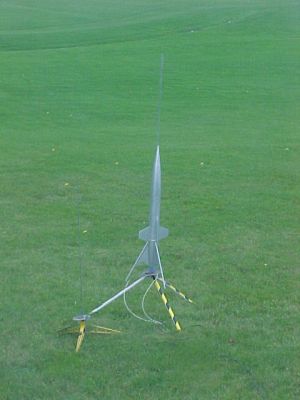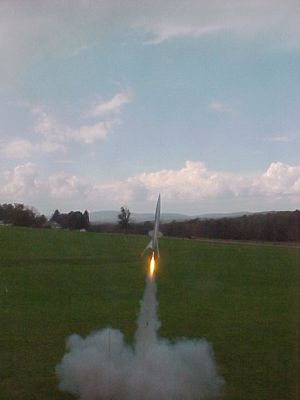Pemberton Technologies M2 Mars Challenger
Pemberton Technologies - M2 Mars Challenger {Kit}
Contributed by Drake "Doc" Damerau
| Construction Rating: | starstarstarstarstar_border |
| Flight Rating: | starstarstarstarstar |
| Overall Rating: | starstarstarstarstar |
| Manufacturer: | Pemberton Technologies  |
Brief:
The M2 is another kit from the '50s retro line at Pemberton Technologies. This
HPR kit comes with lots of parts and a great instruction book. Keeping with the
humorous style, the instructions take you step-by-step through the unusual and
challenging build.
Construction:
There are lots of high quality parts in this kit. From the PML tail cone to the
parachute, all the components are first rate.
I can't stress enough: read the directions before you start. All Pem Tech kits are unusually designed and don't go together like other kits. Take your time and don't try to second guess the build. There is no skill level listed on the kit, but I would put it at a skill level 4. The 21 fun-filled pages of instructions have 30 pictures and illustrations to help you through it. The instructions are as fun to read as they are informative.
Although the fins and landing legs are cut, there is still a lot of cutting to do. The tail cone/MMT/fin section is the most difficult build on this kit. The tail cone needs to be slotted for the fins and the root edge is angled to match up with the motor mount. Getting everything lined up and glued in place was a challenge. Patience prevailed and mine came out perfect. This tail cone assembly ends up being quite heavy so lots of nose weight gets added to the nose cone.
The ½" tubular nylon shock cord gets attached to the body tube by a loop of Kevlar® string. I'm a little nervous about this breaking after several flights, and because it sticks out further than the body tube, I'm worried that it will cause a zipper. On the other hand, this will prevent the nylon shock cord from ever being scorched during ejection. My tip here would be to glue it down far enough so that the shock cord is below the tube opening. This will prevent the Kevlar® string from zippering the tube. I'm on the fence on this one so I'm not going to deduct points here. Time will tell.
Finishing:
This kit took several sessions of priming, sanding, and filling, but the
unusual design made it all worth the effort. I went with Rustoleum primer and
metallic silver to finish it off. Something like this really should be painted
chrome, but I've never had luck with chrome paint.
Construction Rating: 4 out of 5
Flight:
I went with the smallest motor I felt would safely lift this bird. At 23oz,
it's quite a heavy bird. The first flight was on an AT F20-4. The flight was
sweet with a nice slow roll as it ascended into the heavens.
Recovery:
The delay was slightly long but no troubles arose as the chute came out. This
was a great first motor for this rocket.
Flight Rating: 5 out of 5
Overall Rating: 5 out of 5
Other Reviews
- Pemberton Technologies M2 Mars Challenger By James Gartrell
Brief: Wow! This is a great kit. Layne has done another superb job of capturing the magic of Sci-Fi in this 2.5" diameter 29mm rocket. Colonel Carruthers would be as proud to see this rocket as he would the rescue ship. I was a little worried about the dowels hanging off the back, but following Layne's instructions for installation results in a solid fin unit that can take ...
 |
 |
Flights
Date | Flyer | Rocket | Altitude |
|---|---|---|---|
 |
 |
Sponsored Ads
 |
 |















J.R.G. (April 14, 2008)